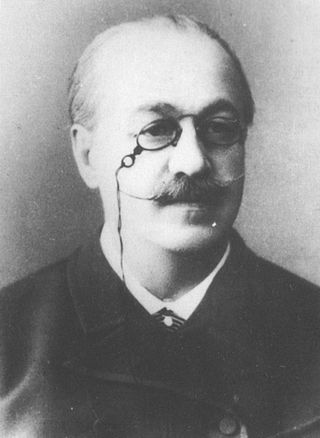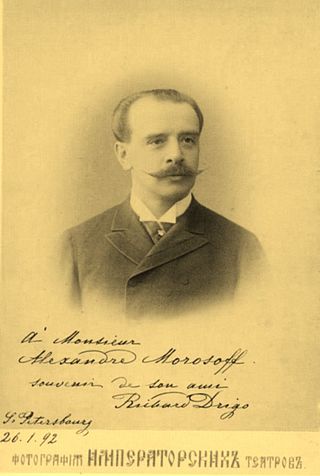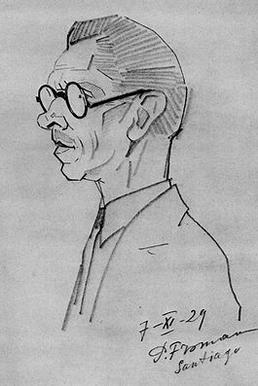
The Bolshoi Ballet is an internationally renowned classical ballet company based at the Bolshoi Theatre in Moscow, Russia. Founded in 1776, the Bolshoi is among the world's oldest ballet companies. In the early 20th century, it came to international prominence as Moscow became the capital of Soviet Russia. The Bolshoi has been recognised as one of the foremost ballet companies in the world. It has a branch at the Bolshoi Ballet Theater School in Joinville, Brazil.
The Pharaoh's Daughter, is a ballet choreographed by Marius Petipa to music by Cesare Pugni. The libretto was a collaboration between Jules-Henri Vernoy de Saint-Georges and Petipa from Théophile Gautier's Le Roman de la momie. It was first presented by the Imperial Ballet at the Imperial Bolshoi Kamenny Theatre, in St. Petersburg, Russia, on 18 January 1862, with the design by A. Roller, G. Wagner (scenery), Kelwer and Stolyakov (costumes).

Marius Ivanovich Petipa, born Victor Marius Alphonse Petipa, was a French and Russian ballet dancer, pedagogue and choreographer. Petipa is one of the most influential ballet masters and choreographers in ballet history.

Le Corsaire is a ballet typically presented in three acts, with a libretto originally created by Jules-Henri Vernoy de Saint-Georges loosely based on the poem The Corsair by Lord Byron. Originally choreographed by Joseph Mazilier to the music of Adolphe Adam and other composers, it was first presented by the ballet of the Théâtre Impérial de l’Opéra in Paris on 23 January 1856. All modern productions of Le Corsaire are derived from the revivals staged by the Ballet Master Marius Petipa for the Imperial Ballet of St. Petersburg throughout the mid to late 19th century.

La Fille mal gardée is a comic ballet presented in two acts, inspired by Pierre-Antoine Baudouin's 1765 painting, La réprimande/Une jeune fille querellée par sa mère. The ballet was originally choreographed by the Ballet Master Jean Dauberval to a pastiche of music based on fifty-five popular French airs. The ballet was premiered on 1 July 1789 at the Grand Théâtre de Bordeaux in Bordeaux, France under the title Le ballet de la paille, ou Il n'est qu'un pas du mal au bien.

Lev Ivanovich Ivanov was a Russian ballet dancer and choreographer and later, Second Balletmaster of the Imperial Ballet. As a performer with the Imperial Ballet, he achieved prominence after performing as an understudy in a benefit performance of La Fille Mal Gardée. He is most famous as the choreographer of Acts II and IV of Swan Lake, which include the Dance of the Little Swans, Act II of Cinderella, and The Nutcracker, which he choreographed alongside Marius Petipa.

Riccardo Eugenio Drigo was an Italian composer of ballet music and Italian opera, a theatrical conductor, and a pianist.

The Saint Petersburg Imperial Bolshoi Kamenny Theatre was a theatre in Saint Petersburg.
La Esmeralda is a ballet in three acts and five scenes, inspired by the 1831 novel Notre-Dame de Paris by Victor Hugo, originally choreographed by Jules Perrot to music by Cesare Pugni, with sets by William Grieve and costumes by Mme. Copère.

The Sergeyev Collection is an assemblage of materials that document the repertory of the Imperial Ballet of St. Petersburg as it existed at the turn-of-the 20th century. The collection consists primarily of choreographic notation and music for many of the notated works. Also included are designs for stage décor and costumes, photos, and theatre programmes for performances of the Imperial Ballet at the turn-of-the 20th century. The choreographic notations of the Sergeyev Collection record—in varying degrees of detail—the original works and revivals of the choreographer Marius Petipa, who served as Premier Maître de ballet of the St. Petersburg Imperial Theatres from 1871 until 1903. Also included is notation for choreography by Lev Ivanov, who served as Second Maître de ballet of the St. Petersburg Imperial Theatres from 1885 until his death in 1901. The dance sections of several operas are also among the notated choreographies of the Sergeyev Collection, the majority of which are the work of Petipa and Ivanov, respectively.
The Parisian Market is a comic ballet in one act, with libretto and choreography by Marius Petipa and music by Cesare Pugni.
La Prima Ballerina, ou L'embuscade or The Traveling Dancer is a ballet in one act, with choreography by Marius Petipa, music by Cesare Pugni and libretto by Paul Taglioni. It was based on a ballet created by Paul Taglioni for the Ballet of Her Majesty's Theatre, London first presented on June 14, 1849.

Catarina ou la Fille du bandit is a ballet in three acts and four scenes, with libretto and choreography by Jules Perrot and music by Cesare Pugni. The libretto is based on an incident in the life of the Italian painter Salvator Rosa. The work was first presented by the Ballet of Her Majesty's Theatre on 3 March 1846 in London, England, with Lucile Grahn, Louis-François Gosselin, and Jules Perrot.
The Two Stars or The Stars or The Two Little Stars is an Anacreontic ballet in 1 act, with choreography by Marius Petipa, and music by Cesare Pugni. Libretto by Marius Petipa, based on an ancient Greek myth.

La Vivandière is a ballet in one act with choreography by Arthur Saint-Léon and Fanny Cerrito, and music by Cesare Pugni.
The 1895 Petipa/Ivanov/Drigo revival of Swan Lake is a famous version of the ballet Swan Lake,, . This is a ballet by Pyotr Ilyich Tchaikovsky based on an ancient German legend, presented in either four acts, four scenes, three acts, four scenes or, more rarely, in two acts, four scenes. Originally choreographed by Julius Reisinger to the music of Pyotr Ilyich Tchaikovsky, it was first presented as The Lake of the Swans by the Ballet of the Moscow Imperial Bolshoi Theatre on 20 February/4 March 1877 in Moscow, Russia. Although the ballet is presented in many different versions, most ballet companies today base their stagings both choreographically and musically on this revival by Marius Petipa and Lev Ivanov, staged for the Imperial Ballet, first presented on 15 January/27 January 1895, at the Imperial Mariinsky Theatre in St. Petersburg, Russia instead of the original version.

Le Poisson doré is a "fantastic ballet" in 4 acts/6 scenes with prologue and epilogue. The choreography was by Arthur Saint-Léon, and the music by Ludwig Minkus.

Alexander Gorsky, a Russian ballet choreographer and a contemporary of Marius Petipa, is known for restaging Petipa's classical ballets such as Swan Lake, Don Quixote, and The Nutcracker. Gorsky "sought greater naturalism, realism, and characterization" in ballet. He valued acting skills over bravura technique. His interpretations of ballets were often controversial and he often used artists outside the dance world to create sets and costumes. The victim of deteriorating mental health in his later life, he died in a mental hospital.

Ludwig Minkus, also known as Léon Fyodorovich Minkus, was an Austrian composer of ballet music, a violinist and teacher of music.
Sofia Nikolayevna Golovkina was a Soviet and Russian ballet dancer, choreographer and teacher. A graduate of the Moscow State Academy of Choreography in 1933, she was the principal dancer of the Bolshoi Ballet till 1959. In 1960, she became director of the Moscow Bolshoi Ballet School. For her work, Golovkina was awarded the Russian Order of Merit, People's Artist of the USSR, and the Order of the Red Banner of Labour. She died in 2004 in Moscow.












